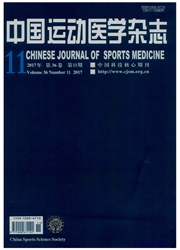

 中文摘要:
中文摘要:
目的:探讨一次性向心运动对白介素6(IL-6)抗炎效应的影响,及PGC-1α在其中的角色。方法:2月龄雄性C57BL/6小鼠70只,建立一次性上坡跑运动模型(速度10 m/min,坡度5°),分别选取运动前(Control),运动30 min和60 min(E30,E60),运动恢复期30 min、60 min、3 h和6 h(PE30、PE60、PE3h、PE6h)为实验观测点,每组10只动物。二氯荧光素法检测骨骼肌线粒体活性氧(ROS)生成速率,硫代巴比妥酸法检测骨骼肌MDA含量,荧光定量PCR法检测骨骼肌白细胞介素6(IL-6)、肿瘤坏死因子-α(TNF-α)、过氧化物酶体增殖活化受体γ共激活因子-1α(PGC-1α)和核因子-κB(NF-κB)p65 m RNA表达。结果:与Control组相较,ROS生成速率在E30、E60、PE30、PE60和PE3h组显著升高(P〈0.01);MDA含量在各组均无显著性变化(P〉0.05);IL-6 m RNA表达水平在E30、E60和PE30组显著升高(P〈0.05);TNF-αm RNA表达水平在PE60和PE3h组显著升高(P〈0.01);PGC-1αm RNA表达水平在E30、E60、PE30、PE60和PE3h组显著升高(P〈0.01);NF-κB p65 m RNA表达水平在PE60和PE3h组显著升高(P〈0.01)。结论:一次性向心运动可诱导具有抗炎效应的IL-6脉冲式表达升高。PGC-1α可能通过抑制ROS的氧化应激损伤及NF-κB表达两条途径抑制炎症,参与调节向心运动中骨骼肌IL-6的抗炎效应。
 英文摘要:
英文摘要:
Objective To investigate the impact of an acute concentric exercise on the anti-inflammation of IL-6 and the role of PGC-1α in such process. Methods 70 two-month old male C57BL/6 mice were divided into control group,30-min exercise group(E30),60-min exercise group(E60),and 30-min,60-min,3-hour,and 6-hour after exercise groups(PE30,PE60,PE3 h and PE6 h,respectively). Mice in exercise groups performed a continuous concentric exercise at the speed of 10m/min with 5% slope. Mitochondrial ROS generation rate,contents of MDA,IL-6,TNF-α,PGC-1α,and NFκB-p65 m RNA were determined. Results As compared to the control group,(1)mitochondrial ROS generation rate increased significantly in E30,E60,PE30,PE60 and PE3 h groups(P〈0.01) and the MDA content in all groups remained unchanged(P〈0.05);(2)IL-6 m RNA level in E30,E60 and PE30 groups,TNF-α m RNA level in PE60 and PE3 h groups,PGC-1αm RNA content in E30,E60,PE30,PE60 and PE3 h groups,and NF-κB p65 m RNA level in PE60 and PE3 h groups increased significantly(P〉0.05 ~P〈0.01). Conclusion An acute concentric exercise could induce higher impulse-type expression of muscle-derived interleukin-6 mediated by PGC-1α through inhibition of oxidative damage induced by ROS and inactivation of NF-κB.
 同期刊论文项目
同期刊论文项目
 同项目期刊论文
同项目期刊论文
 期刊信息
期刊信息
